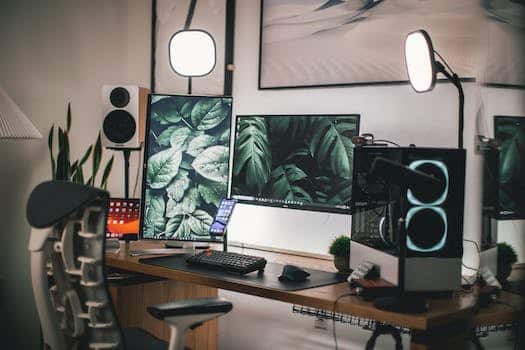Creating the perfect remote work desk setup is essential for maximizing productivity and comfort. In this ultimate guide, we will explore various tips, tricks, and must-have accessories to help you create the best remote work environment. Whether you are a freelancer, remote employee, or digital nomad, this guide will provide valuable insights to optimize your workspace and enhance your work-from-home experience.
- 1. Choosing the right desk for remote work
- 1.1. Consider the size and layout of your workspace
- 1.2. Prioritize comfort and ergonomics
- 1.3. Look for adjustable features
- 1.4. Consider storage options
- 1.5. Choose a desk that fits your style
- 2. Essential equipment for a remote work desk setup
- 2.1. High-quality monitor and ergonomic stand
- 2.2. Comfortable and adjustable office chair
- 2.3. Ergonomic keyboard and mouse
- 2.4. Dependable internet connection and router
- 2.5. Proper lighting and noise-canceling headphones
- 3. Organizing your remote work desk
1. Choosing the right desk for remote work
When it comes to setting up a remote work desk, choosing the right desk is crucial. Your desk is where you’ll be spending most of your day, so it’s important to find one that is comfortable, functional, and suits your needs.
There are several factors to consider when selecting a desk for remote work. First, think about the size of your workspace. If you have a dedicated home office, you may have more room to work with and can opt for a larger desk. However, if you’re working in a small apartment or shared space, a compact desk that fits well in your area may be more suitable.
Next, consider the style and design of the desk. It should fit in with your overall aesthetic and create a productive atmosphere. Some people prefer minimalistic designs, while others may opt for a more traditional or modern look. Additionally, consider the material of the desk. Solid wood desks are durable and provide a classic feel, while metal or glass desks can give a more contemporary vibe.
Ergonomics is another important aspect to consider. A desk that promotes good posture and offers adjustable features can greatly enhance your comfort and productivity. Look for desks with adjustable height options, ergonomic keyboard trays, and built-in cable management systems.
Lastly, consider the storage options provided by the desk. Depending on your work requirements, you may need drawers or shelves to keep your essentials organized and easily accessible. Some desks come with built-in storage solutions, while others may require additional storage units.
Remember, your remote work desk is an investment in your productivity and well-being. Take the time to research and choose a desk that aligns with your needs and preferences. With the right desk, you can create a comfortable and efficient workspace that enhances your remote work experience.
1.1. Consider the size and layout of your workspace
When setting up your remote work desk, one important factor to consider is the size and layout of your workspace. The size of your desk should be suitable for your needs, providing enough surface area to accommodate your computer, monitor(s), keyboard, and any other necessary equipment. It’s crucial to have enough space to work comfortably without feeling cramped or restricted.
Additionally, the layout of your workspace plays a significant role in your productivity and overall well-being. Ideally, your desk should be positioned in a way that maximizes natural light, as it can enhance your mood and energy levels. Avoid placing your desk directly in front of a window to prevent glare on your screen, but try to position it nearby to benefit from the natural light.
Consider the flow of your workspace as well. Ensure that your desk allows for easy movement and access to other areas of your workspace, such as filing cabinets or shelves. A clutter-free and well-organized desk can help promote focus and efficiency.
In summary, choose a desk that fits the size requirements of your remote work setup and consider the layout of your workspace. By selecting the right desk, you can create a comfortable and productive environment for your remote work endeavors.
1.2. Prioritize comfort and ergonomics
When setting up a remote work desk, one of the most important factors to consider is prioritizing comfort and ergonomics. Since you’ll be spending long hours at your desk, it’s crucial to choose a desk that promotes good posture and reduces strain on your body.
There are several key elements to consider when selecting the right desk for remote work. Firstly, the desk should be at an appropriate height that allows you to sit with your feet flat on the floor and your knees at a 90-degree angle. This helps in maintaining proper blood circulation and prevents discomfort in your lower body.
Additionally, the desk surface should provide enough space to accommodate your work essentials, such as a laptop, documents, and any other equipment you may need. Having ample space helps in keeping your desk organized and minimizes clutter, allowing for better focus and productivity.
Another important aspect to consider is the desk’s material and construction. Opt for a sturdy and durable desk that can withstand daily use and supports the weight of your equipment. A solid wood or metal desk is often a good choice, as it offers stability and longevity.
Lastly, don’t forget about the importance of ergonomics. Look for desks that offer adjustable features, such as height-adjustable legs or a tilting surface. These features allow you to customize the desk to fit your specific needs and promote a comfortable working position.
By prioritizing comfort and ergonomics when choosing a desk for remote work, you can create a workspace that not only enhances your productivity but also takes care of your physical well-being.
1.3. Look for adjustable features
When choosing the right desk for remote work, it is important to look for adjustable features that can enhance your productivity and comfort. Adjustable desks allow you to customize the height and angle of the surface, ensuring that you can find the perfect ergonomic position. This is particularly important for long hours of work, as it helps prevent strain and fatigue on your body.
One of the key adjustable features to consider is the height of the desk. A desk with adjustable height allows you to switch between sitting and standing positions, promoting better blood circulation and reducing the risk of sedentary-related health issues. Look for desks that have a smooth and easy-to-use height adjustment mechanism.
Another important feature to look for is an adjustable keyboard tray or shelf. This allows you to position your keyboard and mouse at the ideal height and angle, preventing wrist strain and promoting proper posture. A comfortable typing position can greatly enhance your overall work experience.
Additionally, adjustable monitor stands or mounts are worth considering. These allow you to position your monitor at eye level, reducing neck and eye strain. It is important to have your screen at a comfortable height and distance to avoid any discomfort or vision problems.
Lastly, don’t forget about storage and organizational features. Look for desks with adjustable shelves, drawers, or compartments where you can keep your work essentials neatly organized. This will help you maintain a clutter-free workspace and improve your efficiency.
In conclusion, when creating the best remote work desk setup, prioritize adjustable features that can optimize your comfort, posture, and overall well-being. Investing in a desk with adjustable height, keyboard tray, monitor stand, and storage options will greatly contribute to your productivity and make your remote work experience more enjoyable.
1.4. Consider storage options
When setting up a remote work desk, one of the most important considerations is storage options. Having adequate storage space is essential for staying organized and productive. Here are some factors to consider when choosing the right desk with optimal storage capabilities.
First, assess your storage needs. Take stock of the items you typically use while working, such as documents, files, stationery, and electronic devices. This will help you determine the amount of storage space required.
Next, consider the desk’s design and layout. Look for desks that offer built-in storage solutions, such as drawers, shelves, or compartments. These features can help you keep your workspace clutter-free and ensure easy access to essential items.
Additionally, think about the size of the desk. If you have limited space, a compact desk with vertical storage options, such as tall shelves or wall-mounted organizers, might be a practical choice. On the other hand, if you have more room, a larger desk with ample storage capacity can accommodate all your work essentials.
Furthermore, take into account the accessibility of the storage compartments. Opt for desks that provide easy access to frequently used items. Consider adjustable shelves or drawers with dividers to customize the storage space according to your needs.
Lastly, think about the aesthetic aspect. Choose a desk that matches your personal style and complements your home office decor. A visually appealing desk can enhance your overall work environment and boost your motivation.
By considering these storage options when choosing the right desk for remote work, you can create a functional and organized workspace that promotes productivity and efficiency.
1.5. Choose a desk that fits your style
When setting up your remote work desk, it is important to choose a desk that fits your personal style and preferences. Your desk will be the central piece of furniture in your workspace, so it is crucial to select one that not only suits your aesthetic taste but also meets your functional needs.
There are various factors to consider when choosing the right desk for remote work. Firstly, think about the size of the desk. Assess the space you have available in your home office or designated work area and determine how much surface area you require. If you primarily work on a laptop, a smaller desk may suffice. However, if you need multiple monitors or have other equipment, you may need a larger desk.
Additionally, consider the layout and design of the desk. Some people prefer a minimalist, clean design, while others may opt for a more traditional or vintage look. Choose a desk that complements your overall workspace aesthetic and promotes a positive and productive environment.
Ergonomics is another crucial aspect to consider. Look for a desk that allows for proper ergonomics to prevent discomfort or strain during long hours of work. Adjustable height desks are highly recommended as they enable you to switch between sitting and standing positions, promoting better posture and reducing the risk of musculoskeletal issues.
Lastly, don’t forget about storage options. Depending on your needs, you may require a desk with built-in drawers or shelves to keep your workspace organized and clutter-free. Having a designated space for your documents, stationery, and other essentials can greatly enhance productivity.
In conclusion, choosing the right desk for remote work is essential for creating an optimal workspace. Consider the size, layout, ergonomics, and storage options when making your decision. By selecting a desk that fits your style and meets your functional needs, you can create a comfortable and efficient remote work environment.
2. Essential equipment for a remote work desk setup
When it comes to setting up a remote work desk, having the right equipment is crucial for productivity and comfort. Here are some essential items you should consider for your remote work desk setup:
1. Ergonomic Chair: Invest in a high-quality ergonomic chair that provides proper support for your back and promotes good posture. This will help prevent any discomfort or pain that may arise from sitting for long hours.
2. Adjustable Desk: A height-adjustable desk allows you to switch between sitting and standing positions, promoting better blood circulation and reducing the risk of back problems. Look for a desk that is sturdy and spacious enough to accommodate all your work essentials.
3. Dual Monitors: If your work involves multitasking or requires a larger display area, consider setting up dual monitors. This will enhance your productivity by allowing you to have multiple windows and applications open simultaneously.
4. Keyboard and Mouse: Invest in a comfortable keyboard and mouse that offer ergonomic features. Look for options that provide wrist support and are designed to reduce strain on your hands and wrists.
5. Good Lighting: Ensure your workspace is well-lit to reduce eye strain and promote focus. Natural light is ideal, but if that’s not possible, invest in a desk lamp with adjustable brightness settings.
6. Noise-Canceling Headphones: If you often work in a noisy environment or have distractions around you, noise-canceling headphones can be a game-changer. They help block out external sounds and allow you to focus on your work.
7. Cable Management: Keep your desk organized and free from clutter by using cable management solutions. This will not only make your workspace look neater but also prevent any tripping hazards or accidental unplugging of devices.
Remember, creating a comfortable and functional remote work desk setup is essential for maintaining productivity and overall well-being. Invest in the right equipment that suits your needs and preferences, and make sure to personalize your workspace to create a conducive environment for work.
2.1. High-quality monitor and ergonomic stand
When setting up a remote work desk, one of the essential pieces of equipment to consider is a high-quality monitor and an ergonomic stand. Having a reliable monitor with good resolution and color accuracy can significantly enhance productivity and reduce eye strain. Additionally, an ergonomic stand allows for adjustable positioning, helping to create a comfortable and healthy work environment. By investing in a high-quality monitor and ergonomic stand, remote workers can optimize their workspace and improve their overall experience.
2.2. Comfortable and adjustable office chair
A comfortable and adjustable office chair is an essential piece of equipment for a remote work desk setup. Spending long hours sitting at a desk can take a toll on your body, so investing in a chair that provides proper support and comfort is crucial. Look for a chair with adjustable height, lumbar support, and armrests that can be adjusted to your preferred position. Ergonomic features such as a contoured seat and backrest can help maintain good posture and reduce strain on your back and neck. Additionally, consider a chair with breathable and cushioned upholstery to enhance comfort during extended periods of sitting. By choosing a comfortable and adjustable office chair, you can create a workspace that promotes productivity and reduces the risk of discomfort or pain caused by poor seating.
2.3. Ergonomic keyboard and mouse
An ergonomic keyboard and mouse are essential components of a well-designed remote work desk setup. These devices are specifically designed to provide comfort and prevent strain on the hands, wrists, and arms, which is crucial for individuals who spend long hours typing and using the mouse.
Ergonomic keyboards are designed to address the common issue of wrist strain that occurs with traditional keyboards. They feature a curved or split design that allows for a more natural hand and wrist position while typing. Some ergonomic keyboards also have adjustable tilt angles and wrist rests to further enhance comfort.
Similarly, ergonomic mice are designed to support a more natural hand position and reduce strain on the wrist and arm. These mice often have a contoured shape that fits comfortably in the hand and may include additional features such as programmable buttons and adjustable sensitivity.
Investing in an ergonomic keyboard and mouse can significantly improve comfort and reduce the risk of repetitive strain injuries. When choosing these devices, it is important to consider factors such as adjustability, comfort, and compatibility with your computer system. Additionally, taking regular breaks and practicing good posture while working can further contribute to a healthy and productive remote work environment.
2.4. Dependable internet connection and router
A dependable internet connection and router are essential for a remote work desk setup. In today’s digital age, a stable and reliable internet connection is crucial for seamless communication, accessing online resources, and completing tasks efficiently. Without a reliable internet connection, remote workers may experience disruptions, slow loading times, and even dropped calls during important meetings.
To ensure a dependable internet connection, it is advisable to opt for a high-speed internet plan that meets your specific remote work requirements. Consider the bandwidth, download and upload speeds, and any data caps or limitations that may impact your work. Additionally, it is recommended to use a wired connection rather than relying solely on Wi-Fi, as wired connections tend to be more stable and faster.
Equally important is having a quality router that can handle the demands of multiple devices and continuous usage. A router acts as the gateway between your devices and the internet, and a reliable one can help prevent connection issues, improve signal strength, and provide better coverage throughout your workspace.
When choosing a router, look for models that support the latest Wi-Fi standards (e.g., Wi-Fi 6) for faster speeds and better performance. Consider the size of your workspace and the number of devices that will be connected to the router. Some routers also offer features like beamforming technology, which helps direct the Wi-Fi signal towards your devices, further enhancing connectivity.
Investing in a dependable internet connection and router is a worthwhile investment for any remote worker. It ensures a smooth and uninterrupted workflow, eliminates connectivity frustrations, and allows you to make the most out of your remote work experience.
2.5. Proper lighting and noise-canceling headphones
Proper lighting and noise-canceling headphones are essential equipment for a remote work desk setup. These two items play a significant role in creating an optimal work environment and enhancing productivity.
Having proper lighting is crucial for remote workers as it helps reduce eye strain and fatigue. A well-lit workspace not only improves visibility but also creates a positive ambiance. Natural light is the best option, so try to set up your desk near a window. If that’s not possible, invest in good quality desk lamps or overhead lights that provide adequate illumination. Avoid harsh or dim lighting, as it can negatively impact your mood and concentration.
Noise-canceling headphones are a lifesaver when it comes to blocking out distractions and creating a focused work environment. Whether you work in a noisy household or have neighbors with loud pets, noise-canceling headphones can help you maintain your concentration. These headphones use advanced technology to reduce or eliminate background noise, allowing you to immerse yourself fully in your work. Look for headphones that offer comfort for long hours of wear and have excellent sound quality.
In summary, proper lighting and noise-canceling headphones are essential components of a well-equipped remote work desk setup. They contribute to a comfortable and distraction-free work environment, enabling you to perform at your best.
3. Organizing your remote work desk
Creating an organized and efficient remote work desk setup is essential for maximizing productivity and maintaining a healthy work-life balance. Whether you are transitioning to remote work or have been working remotely for a while, having a well-organized desk can greatly improve your focus and efficiency. Here are some tips to help you create the best remote work desk setup:
1. Declutter: Start by removing any unnecessary items from your desk. Keep only the essentials such as your computer, monitor, keyboard, mouse, and a notebook. Clearing the clutter will create a clean and organized workspace.
2. Ergonomics: Pay attention to ergonomics to ensure a comfortable and healthy work environment. Invest in a good chair that provides proper back support and adjustable height. Position your monitor at eye level and use a keyboard and mouse that promote a natural and relaxed posture.
3. Cable Management: Keep your cables organized and out of the way. Use cable clips or cable sleeves to bundle and hide cables behind your desk. This will not only make your desk look neat but also prevent any tripping hazards.
4. Lighting: Adequate lighting is crucial for a productive workspace. Position your desk near a window to take advantage of natural light. If natural light is limited, invest in a good desk lamp that provides bright and adjustable lighting.
5. Personalize: Add personal touches to make your remote work desk setup more enjoyable. Place some plants or photos that inspire you. Choose a color scheme that reflects your personality and creates a positive and motivating atmosphere.
6. Storage Solutions: Invest in storage solutions to keep your desk organized. Use drawers, shelves, or file organizers to store documents, stationery, and other essentials. Having a designated place for everything will save you time and minimize distractions.
By following these tips, you can create a remote work desk setup that is organized, comfortable, and conducive to productivity. Remember to regularly declutter and maintain your desk to ensure a clean and efficient workspace.
3.1. Use cable management solutions
When it comes to organizing your remote work desk, cable management solutions play a crucial role in creating a clean and efficient workspace. With the increasing number of devices and cables involved in remote work setups, it’s important to keep them organized to avoid the hassle of tangled wires and a cluttered desk.
Cable management solutions help you neatly arrange and secure cables, preventing them from tangling and getting in your way. By keeping cables organized, you not only improve the aesthetics of your workspace but also enhance productivity and reduce the risk of accidents.
There are various cable management solutions available in the market, ranging from cable clips, cable sleeves, cable trays, to cable boxes. These solutions provide different methods to keep your cables tidy and out of sight, depending on your preferences and the layout of your desk.
Using cable clips, you can easily attach cables to the edge of your desk or the wall, keeping them in place and preventing them from falling behind or tangling with other cables. Cable sleeves are a great option for managing multiple cables together, as they allow you to bundle them up and hide them under a single sleeve, giving a clean and organized look to your desk.
Cable trays are another effective solution to manage cables. They can be mounted underneath your desk, providing a dedicated space to route and store cables. With cable trays, you can keep your cables off the floor, reducing the risk of tripping over them and making it easier to clean the area.
If you prefer a more discreet option, cable boxes are a popular choice. These boxes have multiple openings to route cables in and out, while keeping them hidden from view. You can place your power strip and excess cables inside the box, maintaining a clutter-free desk surface.
In conclusion, incorporating cable management solutions into your remote work desk setup is essential for maintaining an organized and efficient workspace. Whether you choose cable clips, cable sleeves, cable trays, or cable boxes, these solutions help you keep your cables neatly arranged and out of sight, enhancing both the functionality and visual appeal of your remote work desk.
3.2. Invest in desk organizers and storage solutions
Investing in desk organizers and storage solutions is essential for organizing your remote work desk. With the increasing number of people working from home, it is important to have a well-organized workspace that promotes productivity and efficiency.
Desk organizers such as pen holders, file trays, and cable management systems help keep your desk clutter-free and ensure that everything has its designated place. By having an organized desk, you can easily find the tools and materials you need, saving time and reducing stress.
Storage solutions like drawers, shelves, and bins provide additional space for storing documents, stationary, and other work-related items. They help in creating a neat and tidy workspace, minimizing distractions and allowing you to focus on your tasks.
Investing in high-quality desk organizers and storage solutions not only improves the aesthetic appeal of your remote work desk but also enhances your overall work experience. By keeping your desk organized, you can create a more productive and efficient work environment, leading to better results and increased satisfaction.
In conclusion, investing in desk organizers and storage solutions is a wise decision for anyone working remotely. It allows you to maintain a clutter-free and well-organized desk, promoting productivity and reducing distractions. So, make sure to prioritize organizing your remote work desk and enjoy the benefits it brings to your daily work routine.
3.3. Create a filing system for documents
When it comes to remote work, having an organized filing system for your documents is essential. Without a proper system in place, you can easily lose track of important files and waste valuable time searching for them. Here are some steps to help you create a filing system that will keep your documents organized and easily accessible.
1. Sort and categorize: Start by sorting through your documents and categorizing them into different groups. This could be based on projects, clients, or any other relevant criteria. By grouping similar documents together, you can easily find what you need when you need it.
2. Choose a naming convention: Establishing a consistent naming convention for your files is crucial. This will make it easier to locate specific documents and ensure that everyone on your team understands the system. Consider including important details like the date, project name, or version number in the file name.
3. Create folders: Create folders on your computer or cloud storage platform to store your documents. Use clear and descriptive names for these folders to make it easy to navigate through them. You can have broad categories for major projects or clients and subfolders for more specific topics.
4. Use color-coding: If you prefer a visual way of organizing your files, consider using color-coding. Assign different colors to different categories or types of documents to quickly identify them. You can use colored labels or customize folder icons to make them stand out.
5. Backup your files: It’s crucial to have a backup system in place to protect your documents from loss or damage. Consider using cloud storage services or external hard drives to regularly backup your files. This will give you peace of mind knowing that your important documents are safe and easily retrievable.
By implementing a well-organized filing system, you can streamline your remote work and increase your productivity. With easy access to your documents, you can focus more on your tasks and spend less time searching for files. Take the time to set up an efficient filing system, and you’ll thank yourself in the long run.
3.4. Utilize whiteboards or cork boards for task management
When it comes to organizing your remote work desk, there are a few essential tools that can greatly enhance your task management. Two popular options are whiteboards and cork boards.
Whiteboards are versatile and can be used for various purposes. You can write down your to-do lists, important deadlines, or project milestones on the whiteboard. It allows you to have a visual representation of your tasks and helps you stay focused and organized. Additionally, whiteboards can be easily erased and updated, making them ideal for dynamic work environments.
On the other hand, cork boards provide a tactile way of organizing your tasks. You can pin important documents, notes, or reminders on the cork board. It serves as a physical reminder of your tasks and keeps them within easy reach. Cork boards are particularly useful if you prefer a more hands-on approach to task management.
Whether you choose a whiteboard or a cork board, incorporating these tools into your remote work desk setup can significantly improve your productivity and keep your tasks in order.
3.5. Keep your desk clutter-free and clean
A clutter-free and clean desk is essential for a productive remote work environment. By organizing your remote work desk, you can create a space that promotes focus, efficiency, and creativity. Here are some tips to keep your desk clutter-free and clean:
1. Clear the unnecessary: Start by removing any items from your desk that are not essential for your work. This includes old papers, empty coffee cups, and random knick-knacks. Keep only the items that you frequently use or need for your daily tasks.
2. Use organizers: Invest in desk organizers to keep your belongings neatly arranged. Use trays or containers to store pens, notepads, and other small items. Use a file organizer to keep important documents and papers in order. This will not only declutter your desk but also make it easier to find things when you need them.
3. Create designated spaces: Assign specific areas of your desk for different purposes. For example, have a space for your computer or laptop, a separate area for writing or note-taking, and another section for stationery. This will help you maintain a sense of order and prevent things from getting mixed up.
4. Establish a cleaning routine: Set aside some time each day or week to clean and organize your desk. This could include wiping down surfaces, dusting off your electronics, and tidying up any loose cables. By regularly maintaining your desk, you can prevent clutter from piling up and ensure a clean work environment.
5. Minimize distractions: Keep unnecessary items off your desk that can cause distractions. This includes personal items, excessive decorations, or anything unrelated to your work. A clean and minimalist desk will help you stay focused and avoid getting overwhelmed.
By following these tips, you can create a clutter-free and clean remote work desk that enhances your productivity and concentration. Remember, an organized workspace leads to an organized mind!
Conclusion
In conclusion, creating the best remote work desk setup is essential for productivity and comfort. By following the tips and recommendations mentioned in this ultimate guide, individuals can design a workspace that promotes focus, organization, and overall well-being. From choosing the right desk and chair to optimizing lighting and reducing distractions, these steps will help remote workers create an environment that maximizes their efficiency and allows them to thrive in their remote work journey.






3 Comments
Jacquelin Lani
10 months agoWow, this article on designing the perfect remote work desk setup is exactly what I needed! Ive been struggling to find the right balance between productivity and comfort while working from home. The expert tips and tricks shared here are truly valuable. I cant wait to implement them and create an ideal workspace that will enhance my efficiency and overall well-being. Thank you for sharing such insightful advice!
Mabel Spaulding
10 months agoThank you for sharing these valuable insights on designing the perfect remote work desk setup. Its crucial to prioritize productivity and comfort in our home workspaces, especially in todays remote work environment. With the expert tips and tricks provided in this post, Im confident that I can enhance my work area to optimize my efficiency and overall well-being. Looking forward to implementing these suggestions and reaping the benefits. Appreciate the valuable guidance!
Isadora Orsay
10 months ago{
comment: Thank you for sharing this informative post! Designing an ideal remote work desk setup is crucial for maximizing productivity and ensuring comfort. It is essential to consider ergonomic principles to support good posture and prevent musculoskeletal issues. Factors such as proper desk height, adjustable chairs, and adequate lighting play a significant role. Additionally, organizing cables and using cable management solutions can help maintain a clean and clutter-free workspace. Incorporating dual monitors or a monitor arm can enhance multitasking capabilities. Ergonomic keyboards and mice can reduce strain on the hands and wrists. Lastly, creating a dedicated space with minimal distractions boosts focus and concentration. Overall, implementing these tips and tricks will undoubtedly lead to a more efficient and enjoyable remote work experience.
}